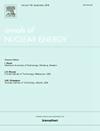Dynamics modeling of molten salt reactor with reduced and expanded representations of delayed neutron precursors
IF 1.9
3区 工程技术
Q1 NUCLEAR SCIENCE & TECHNOLOGY
引用次数: 0
Abstract
Molten salt reactors (MSRs) present unique challenges in dynamic behavior due to the mobility of their fuel. In these reactors, delayed neutron precursors (DNPs) drift with the fuel circulation through the primary loop. As a result, a fraction of DNPs decays outside the core, effectively reducing the available delayed neutron population for reactivity control. Consequently, precise modeling of the distribution and behavior of DNPs is critical for accurate reactor dynamics simulations. In this study, the System Dynamics Analysis Tool (SDAT) was used to simulate a thermal-spectrum MSR under steady-state conditions and following transients. The effects of using reduced and expanded representations of DNPs with fewer or more groups than the conventional 6-group model were investigated. Their impact on the simulated distribution of precursors in the primary loop, reactivity loss value, and reactor response to transients was analyzed. Simulation results showed that reduced models lead to the loss of the actual DNPs distribution data, resulting in less accurate estimates of reactivity loss. Reactor power predictions using these reduced models showed significant deviations compared to those using the conventional 6-group model in transient simulations. Expanded models offered a more accurate representation of the distribution of DNPs and reactivity loss estimates. Reactor power predictions using expanded models showed minimal deviation from the conventional 6-group model during the simulated transients.
用延迟中子前体简化和扩展表示的熔盐堆动力学建模
由于其燃料的流动性,熔盐堆(MSRs)在动态性能方面面临着独特的挑战。在这些反应堆中,延迟中子前体(DNPs)随燃料循环通过主回路漂移。结果,一小部分DNPs在堆芯外衰变,有效地减少了可用于反应性控制的延迟中子数量。因此,对DNPs分布和行为的精确建模对于精确的反应堆动力学模拟至关重要。在本研究中,使用系统动力学分析工具(SDAT)来模拟稳态条件下和以下瞬态下的热谱MSR。研究了与传统的6组模型相比,使用更少或更多组的DNPs缩小和扩大表示的效果。分析了它们对主回路中前驱体的模拟分布、反应性损失值和反应器对瞬态响应的影响。仿真结果表明,简化的模型会导致实际DNPs分布数据的丢失,从而导致反应性损失估计的准确性降低。在瞬态模拟中,使用这些简化模型的反应堆功率预测与使用传统6组模型的预测相比存在显著偏差。扩展模型提供了更准确的DNPs分布和反应性损失估计。在模拟瞬态期间,使用扩展模型的反应堆功率预测与传统的6组模型的偏差最小。
本文章由计算机程序翻译,如有差异,请以英文原文为准。
求助全文
约1分钟内获得全文
求助全文
来源期刊

Annals of Nuclear Energy
工程技术-核科学技术
CiteScore
4.30
自引率
21.10%
发文量
632
审稿时长
7.3 months
期刊介绍:
Annals of Nuclear Energy provides an international medium for the communication of original research, ideas and developments in all areas of the field of nuclear energy science and technology. Its scope embraces nuclear fuel reserves, fuel cycles and cost, materials, processing, system and component technology (fission only), design and optimization, direct conversion of nuclear energy sources, environmental control, reactor physics, heat transfer and fluid dynamics, structural analysis, fuel management, future developments, nuclear fuel and safety, nuclear aerosol, neutron physics, computer technology (both software and hardware), risk assessment, radioactive waste disposal and reactor thermal hydraulics. Papers submitted to Annals need to demonstrate a clear link to nuclear power generation/nuclear engineering. Papers which deal with pure nuclear physics, pure health physics, imaging, or attenuation and shielding properties of concretes and various geological materials are not within the scope of the journal. Also, papers that deal with policy or economics are not within the scope of the journal.
 求助内容:
求助内容: 应助结果提醒方式:
应助结果提醒方式:


